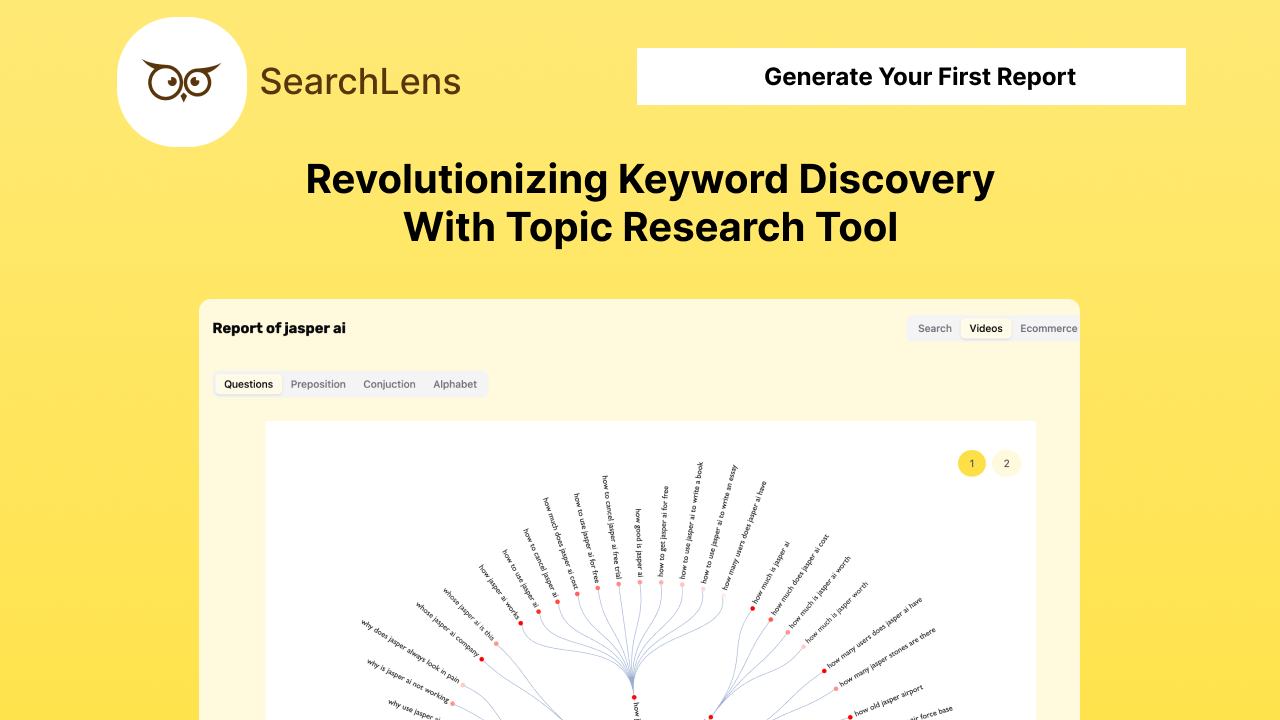
How to gain actionable search insights for SEO?
Unlock Insights, Keyword Trends, and Improve Your Content Strategy with Google and YouTube Data
By Shishir
Published on
5 minutes
Table of Contents
What Are Search Insights?
Search insights are details about what people are searching for and how they’re searching. These insights provide a roadmap for creating content, targeting audiences, and optimizing your website for maximum visibility. Marketers use them to:
- Understand what users want by analyzing search queries and patterns.
- Discover new topics and opportunities for content creation.
- Monitor competitor strategies and stay ahead in the market.
- Improve current content to better serve user needs and boost rankings.
- Align business goals with real-world search behavior for long-term success.
When you understand search insights, you can predict trends, cater to user intent, and fine-tune your SEO approach for better engagement.
Tools for Finding Search Insights
Keyword Research Tools
-
Searchlens: Keyword research can often feel like searching for a needle in a haystack, but with Searchlens, it becomes effortless and efficient. Designed to be your ultimate keyword discovery tool, Searchlens helps you uncover the terms and phrases that truly matter for your SEO and marketing strategy. Here's how:

- Comprehensive Keyword Insights
Searchlens goes beyond basic keyword suggestions by diving deep into various keyword types, including:
-
High-traffic search terms to increase visibility.
-
Long-tail keywords to target niche audiences.
-
Competitive keywords for benchmarking against rivals.
-
Ecommerce-specific terms from platforms like Amazon.
- Topic Clustering Made Easy
Discover related keywords grouped by context and intent to better align your content strategy with user needs. This feature helps you create structured, relevant content that ranks higher in search results.
- Prepositions and Query Expansion
Searchlens identifies how users phrase questions and statements in search engines. By analyzing prepositions like “for,” “with,” and “near,” you can craft content that directly answers user queries.
- Data Export and Customization
Export your research as CSV files for further analysis or PNG files for presentations. This makes sharing insights with your team seamless and efficient.
-
Google Keyword Planner: This tool helps you identify relevant keywords by showing search volume, competition, and cost-per-click (CPC). Use it to uncover the terms most likely to bring traffic to your site.

-
Ahrefs/SEMrush: These tools provide comprehensive data, including keyword difficulty, search volume, competitive analysis, and backlink profiles. They’re excellent for building a complete SEO strategy.
-
AnswerThePublic: Use this tool to find questions, comparisons, and phrases people commonly search for related to your topic, giving you insights into user intent.
Analytics Platforms
- Google Analytics: Analyze where your visitors come from, what they do on your site, and how they engage with your content. This tool provides essential metrics for measuring success.
- Google Search Console: Get performance data directly from Google, including impressions, clicks, and top-performing search queries. Use this to identify areas where you can improve rankings.
Competitor Analysis Tools
- BuzzSumo: Find trending content in your niche and understand what makes it popular. Use this insight to develop your own shareable and engaging content.
- SpyFu: Analyze your competitors' organic and paid search strategies, including the keywords they rank for and their ad performance. This can help you identify opportunities to outperform them.
How to Find Useful Search Insights
Check Search Volume and Trends
- Use Google Trends to spot seasonal patterns, rising topics, and the overall popularity of search terms. This tool helps you stay ahead by focusing on timely and relevant content.
- Long-tail keywords are more specific and less competitive than broad keywords. They often have higher conversion rates because they align closely with user intent. For example, instead of targeting “shoes,” target “comfortable running shoes for beginners.”
Understand Why People Search
Search intent explains the goal behind a query. Knowing this helps you create content that matches what users are looking for. There are three main types:
- Informational: Users want to learn something (e.g., "how to bake a cake").
- Navigational: Users are searching for a specific site or brand (e.g., "Instagram login").
- Transactional: Users are ready to take action, such as buying or signing up (e.g., "best laptops under $500").
Analyze Competitor Keywords
- Tools like Ahrefs or SEMrush can reveal the keywords your competitors are ranking for. Study their content to understand what’s working and where you can do better.
- Look for gaps in their strategy. Are there questions they’re not answering? Topics they’ve overlooked? Fill these gaps with your own content.
Review Your Current Content

- Use Google Search Console to find pages that rank for important keywords but aren’t performing well. Improve these pages by updating the content, adding visuals, and optimizing metadata.
- Look for opportunities to add internal links to improve user experience and boost page authority.
Study User Behavior
- Tools like Hotjar provide heatmaps and session recordings, showing how users interact with your site. Identify areas where visitors drop off and optimize those sections to keep them engaged.
- User feedback and surveys can also give you direct insights into what visitors like and dislike about your site.
Turning Insights into Actions
Organize and Rank Keywords
- Group keywords by their intent (informational, navigational, transactional) and difficulty. This helps prioritize which keywords to target first.
- Focus on keywords with moderate competition and high search volume to maximize your chances of ranking quickly.
Match Keywords to User Needs
Tailor your content to fit each stage of the user journey:
- Top of Funnel (TOFU): Create blog posts, how-to guides, and infographics that address common questions.
- Middle of Funnel (MOFU): Develop comparison articles, case studies, and detailed guides that help users evaluate their options.
- Bottom of Funnel (BOFU): Optimize product pages, landing pages, and CTAs to encourage conversions.
Measure Content Success
- Track key performance indicators (KPIs) like click-through rates (CTR), bounce rates, and conversion rates. These metrics show how well your content is meeting user needs.
- Test different titles, meta descriptions, and CTAs to see what resonates most with your audience.
Using Insights to Boost SEO
Aim for Featured Snippets
- Answer common questions directly and clearly within your content.
- Use structured data and proper formatting (like bullet points and tables) to increase your chances of appearing in featured snippets.
Improve On-Page SEO
- Use primary and secondary keywords naturally in your content. Avoid keyword stuffing, which can hurt your rankings.
- Optimize headings, meta tags, and image descriptions to make your pages more search-friendly.
Write In-Depth Content
- Cover your topic thoroughly, answering all possible questions users might have. Comprehensive content often ranks higher in search engines.
- Break up long sections with headings, bullet points, and visuals to improve readability and user experience.
Build Strong Backlinks
- Reach out to reputable websites in your industry to share your content. Quality backlinks improve your domain authority and rankings.
- Create valuable resources like eBooks, whitepapers, and research reports that others will want to link to.
Track Progress and Adjust
Review Performance Regularly
- Use Google Analytics to track traffic, user engagement, and conversion metrics. Regular reviews help you identify trends and adjust strategies.
- Monitor keyword rankings weekly or monthly to ensure you’re progressing toward your goals.
Change Tactics When Needed
- Pay attention to what’s working and replicate successful strategies.
- Don’t be afraid to abandon underperforming tactics and try new approaches.
Keep Up with SEO Trends
- Follow industry blogs like Moz, Neil Patel, and Search Engine Journal to stay updated on algorithm changes and best practices.
- Experiment with new tools and technologies, such as AI-powered content creators or voice search optimization.
Conclusion

By using these tips, you can find actionable search insights and build an SEO strategy that works. Always focus on giving users helpful and high-quality content—that’s the key to long-term success. With the right tools and a clear plan, you can turn data into results and grow your online presence effectively.